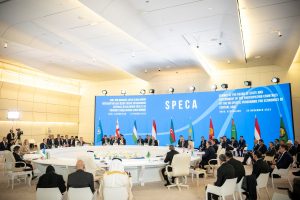
The Turkic states are concerned about how to maintain relations with their compatriots abroad.Continue reading

Viktor Orbán visited Baku, Azerbaijan on Friday, where he attended a conference of the countries participating in the UN Special Program for the Economies of Central Asia (SPECA) at the invitation of the Azerbaijani President, Világgazdaság reports.
“The existence of a safe, predictable, and modern transport route between Europe and Asia is also a fundamental Hungarian national economic interest,” the Hungarian Prime Minister stressed at the event. “Our national economic strategy is based on making Hungary a meeting point for the most advanced companies in the East and West,” he said, outlining future cooperation.

Photo: MTI/Miniszterelnöki Sajtóiroda/Benko Vivien Cher
The Prime Minister pointed out that “we want the global economic era that is now taking shape to be defined by interconnections and cooperation based on mutual respect.” Without connecting Central Asia and Europe, “we cannot create a new successful European economic strategy,” he explained.
We in Europe see Central Asia as a region that connects transport, trade, and digital routes between Europe and the East,”
the Prime Minister emphasized.
The program is being implemented on the basis of cooperation and mutual benefit, transparency, and equality between countries, with the support of external countries and international organizations, says the organization’s constitution.
SPECA countries are involved in several areas, including water and energy development, sustainability and transport, trade, gender equality, and technological development.
The combined GDP of the seven SPECA members in purchasing power parity terms is estimated at USD 1.5 trillion this year. It is comparable in size to the USD 7 trillion economy of the Middle East region, which has 16 countries and nearly three times the population. The region’s main primary exports are crude oil, natural gas, and aluminium, and its main trading partner is China.
Earlier, Foreign Minister Péter Szijjártó said that the importance of Central Asia has increased in recent years, and Hungary started building relations with the countries of the region much earlier than other players. Therefore, he believes that Hungary has a competitive advantage in this respect today. This is reflected in Hungarian-Kyrgyz trade, which grew by a record 71 percent last year, and has also seen a 3.5-fold increase this year until mid-July.
Via Világgazdaság, Featured image: MTI/Miniszterelnöki Sajtóiroda/Benko Vivien Cher